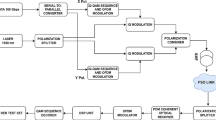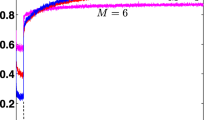Abstract
For Multi-Carrier-Code Division Multiple Access (MC-CDMA) systems, it is usually assumed that the fading of the subcarriers is frequency non-selective and independent of each other. This paper shows that the two assumptions are incompatible. In fact, the MC-CDMA signals at each subcarrier undergo fading that are highly correlated. Based on this observation, this paper develops a simulation algorithm for Rayleigh fading channels via frequency-domain correlation function, which incorporates the Doppler effect simultaneously. Numerical examples are presented to demonstrate the effectiveness of the new algorithm, with the conclusion that the independence assumption of subcarrier fading overrates the system performance.
Similar content being viewed by others
References
N. Yee, J. P. Linnartz, G. Fettweis. Multi-carrier CDMA in indoor wireless radio networks. IEICE Trans. on Commun., E77-B(1994)7, 900–904.
Younsun Kim, et al. Effect of carrier frequency offset on performance of MC-CDMA systems. Electron. Lett., 35(1999)5, 378–379.
J. P. Linnartz. Performance analysis of synchronous MC-CDMA in mobile Rayleigh channel with both delay and Doppler spreads. IEEE Trans. on Vehicular Technology, 50(2001)6, 1375–1387.
S. Kondo, L. B. Milstein. Performance of multicarrier DS CDMA systems. IEEE Trans. on Commun., 44(1996)2, 238–246.
T. M. Lok, T. F. Wong, J. S. Lehnert. Blind adaptive signal reception for MC-CDMA systems in Rayleigh fading channels. IEEE Trans. on Commun., 47(1999)3, 464–471.
B. Natarajan, et al. Generation of correlated Rayleigh fading envelopes for spread spectrum applications. IEEE Commun. Lett., 4(2000)1, 9–11.
J. G. Proakis. Digital Communications. 4th ed. New York, McGraw-Hill, 2001, 800–809.
S. Hara, R. Prasad. Design and performance of multicarrier CDMA system in frequency-selective Rayleigh fading channels. IEEE Trans. on Vehicular Technology, 48(1999)5, 1584–1595.
S. Hara, R. Prasad. Overview of multicarrier CDMA. IEEE Commun. Mag., 35(1997)12, 126–133.
Y. R. Zheng, C. Xiao. Improved models for the generation of multiple uncorrelated Rayleigh fading waveforms. IEEE Commun. Lett., 6(2002)6, 256–258.
Author information
Authors and Affiliations
Corresponding author
Additional information
Supported by the Major Program of the National Natural Science Foundation of China (No.60496311).
Communication author: Han Fangming, born in 1974, male, Ph.D. candidate. National Laboratory of Radar Signal Processing, Xidian University, Xi’an 710071, China.
About this article
Cite this article
Han, F., Zhang, X. Computer simulation of Rayleigh fading channels in MC-CDMA systems. J. of Electron.(China) 24, 577–582 (2007). https://doi.org/10.1007/s11767-006-0003-y
Received:
Revised:
Issue Date:
DOI: https://doi.org/10.1007/s11767-006-0003-y
Key words
- Multi-Carrier-Code Division Multiple Access (MC-CDMA)
- Rayleigh fading
- Channel simulation
- Frequency-domain correlation




